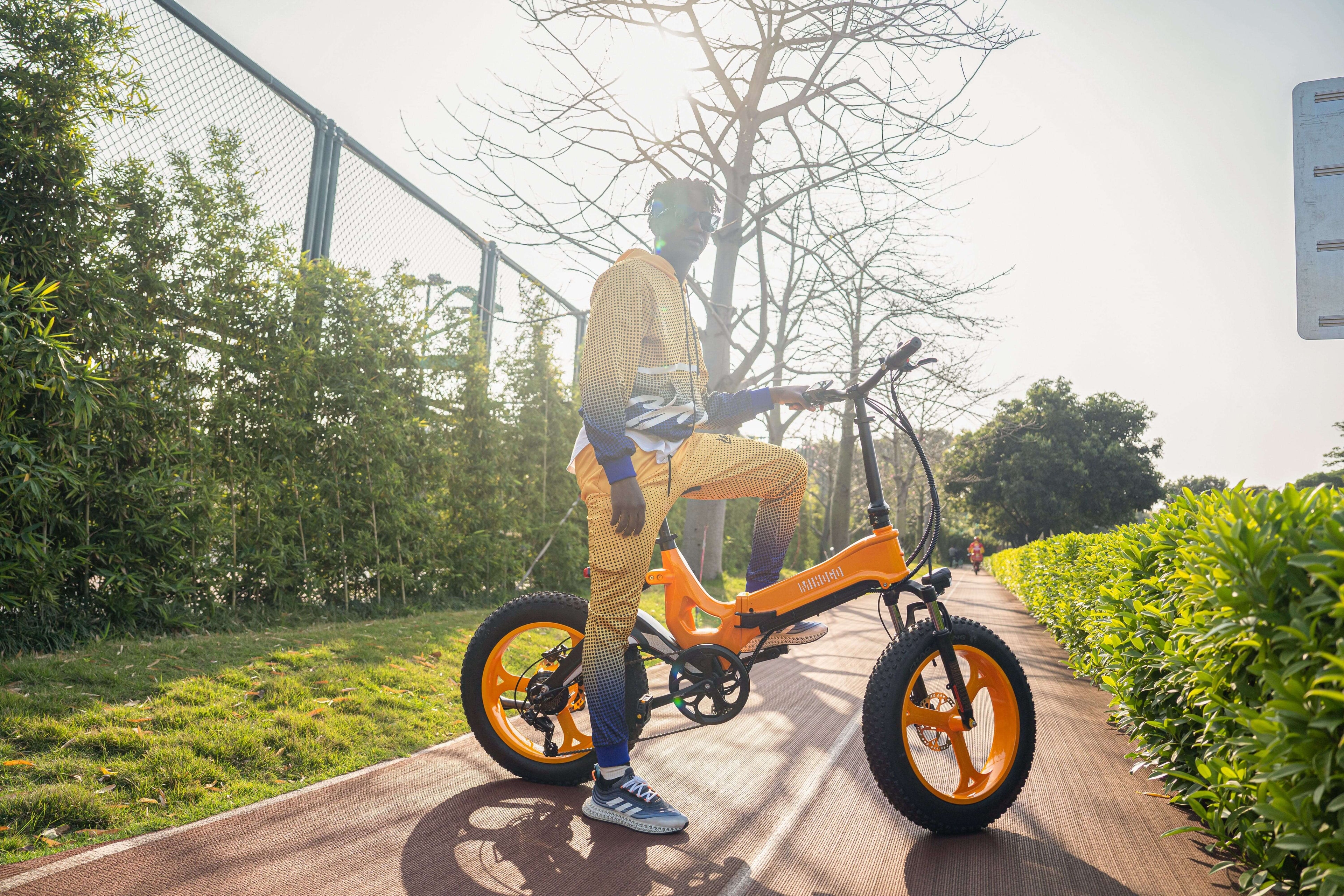Understanding Your E-Bike Battery System
Modern e-bike batteries are sophisticated power systems. Your Mihogo uses advanced lithium-ion technology combined with a Battery Management System (BMS) that protects and optimizes performance. Understanding how these components work together is the first step to effective troubleshooting.
The BMS acts as your battery's brain, monitoring cell voltage, regulating charging and discharging, and protecting against dangerous conditions like overheating or overcharging. When issues arise, they often stem from the battery cells themselves, the BMS, or external factors like charging equipment and connections.
Problem 1: Battery Not Charging
Common Symptoms
- Charger indicator light stays red or doesn't turn on
- Battery won't accept any charge
- Charging takes unusually long
- Battery appears dead despite being plugged in
Step-by-Step Solutions
Check the Power Source Before diving into complex troubleshooting, verify the basics. Test your wall outlet by plugging in another device like your phone charger. A surprising number of charging issues stem from tripped circuit breakers or faulty outlets.
Inspect Your Charger Examine the charger for visible damage to the cable, plug, or housing. Plug the charger into the wall outlet without connecting it to the battery. Check if the indicator light turns on. If it doesn't illuminate, your charger may be defective and needs replacement.
Clean Battery Terminals Dirt, corrosion, or debris on battery terminals can prevent proper electrical connection. Remove the battery from your Mihogo and inspect both the battery terminals and the charging port. Use a dry cloth or fine sandpaper to gently clean any corrosion. Ensure all connections are dry before reconnecting.
Verify Battery Pin Alignment Battery connector pins must align properly to complete the charging circuit. Misaligned pins prevent charging even with a functional charger. Inspect the pins and gently realign them if necessary using a small wrench or pliers.
Test Battery Voltage Use a multimeter to check your battery's actual voltage. A fully charged 48V battery should read approximately 54.6V, while a 36V battery should show around 42V. If readings are significantly lower than expected or show zero voltage, internal cell damage may have occurred.
According to battery testing standards from electrical engineering resources, voltage readings help identify whether the issue lies with the battery cells, BMS, or charging equipment.
Reset the BMS Sometimes the BMS enters protective mode due to detected errors. Resetting it often resolves charging issues:
- Turn off your Mihogo completely
- Remove the battery
- Wait 10-30 minutes to allow residual power to dissipate
- If your battery has a reset button, press and hold it for 10-20 seconds
- Reconnect the battery and attempt charging again
Problem 2: Reduced Range and Power
Common Symptoms
- Your Mihogo doesn't travel as far on a full charge
- Battery percentage drops rapidly during rides
- Noticeable power loss, especially on hills
- Battery gauge shows inconsistent readings
Diagnosing Range Issues
Battery Degradation Lithium-ion batteries naturally lose capacity over time. After 500-1000 charge cycles, you may notice 10-20% range reduction. This gradual decline is normal aging and doesn't necessarily require immediate battery replacement.
However, sudden dramatic range loss indicates a more serious problem that needs attention.
Check Battery Health Monitor your battery's performance over several rides. Note how many miles you achieve on different assist levels and terrain types. Compare this to your Mihogo's specifications. A significant deviation suggests battery health issues.
Environmental Factors Temperature dramatically affects battery performance. Cold weather can reduce range by 20-30% temporarily. Extremely low temperatures reduce battery energy storage capacity, and it's normal for e-bike range to decrease in winter conditions. Store your battery at room temperature before rides in cold weather.
Riding Habits Impact Your riding style significantly affects range. Using the highest assist level constantly drains the battery faster. Frequent stops and starts, excessive weight, underinflated tires, and constant headwinds all reduce efficiency.
Solutions to Extend Range
Optimize Riding Style
- Use lower assist levels on flat terrain
- Pedal actively to support the motor
- Maintain steady speed rather than frequent acceleration
- Coast when possible instead of using throttle
Maintain Proper Tire Pressure Underinflated tires create rolling resistance that forces your motor to work harder. Check tire pressure weekly and inflate to manufacturer recommendations.
Perform Full Discharge-Recharge Cycles Recalibrate your BMS every 3-4 months by fully draining the battery until it shuts off, then charging to 100% without interruption. This helps the BMS accurately track actual capacity.
Battery Storage Best Practices When storing your battery for extended periods, keep it at 50-60% charge and store at room temperature between 15-20°C. Never store at full charge or completely depleted.
Problem 3: Battery Fully Charged But Not Working
Common Symptoms
- Display shows 100% but bike won't turn on
- Battery voltage tests normal but provides no power
- Bike cuts out despite full charge indicator
- Power button doesn't respond
Troubleshooting Steps
Check All Connections Loose connections are among the most common reasons an e-bike won't turn on despite showing full charge. Remove and firmly reseat the battery in its compartment. Inspect all visible wire connections between the battery, controller, and motor.
Reset the BMS A tripped BMS can display full charge while blocking power delivery. Follow the reset procedure outlined above: disconnect the battery for 10-30 minutes to clear error codes.
Inspect for Blown Fuses Many batteries contain internal fuses that blow during electrical surges. Consult your Mihogo user manual to locate the fuse. If blown, replace it with an identical rated fuse. Repeated fuse failures indicate underlying electrical problems requiring professional diagnosis.
Test Under Load Use a multimeter to measure voltage while applying load. If voltage drops significantly under load despite showing full when idle, the BMS may have tripped protection mode or internal cells have failed.
Problem 4: Battery Overheating
Warning Signs
- Battery case feels excessively hot to touch
- Display shows temperature warnings
- Battery automatically shuts down during use
- Unusual smells coming from battery
Immediate Actions
Stop Using Immediately If your battery overheats, stop riding and turn off the system. Allow the battery to cool completely before attempting to use or charge it again.
Check for Causes
- Riding at maximum assist on steep inclines for extended periods
- Charging in direct sunlight or hot environments
- Blocked ventilation around battery compartment
- Using incompatible charger producing excessive current
Prevention Strategies
Proper Charging Environment Always charge in a cool, dry, well-ventilated area away from direct sunlight. According to lithium-ion battery safety guidelines, charging at extreme temperatures can cause battery malfunction and safety risks.
Moderate Riding Demands Give your motor and battery breaks during intense riding. Use lower assist levels when possible and avoid sustained high-power demands.
Ensure Adequate Ventilation Don't block battery ventilation slots with bags or covers. Allow air circulation around the battery during use and charging.
Problem 5: Battery Won't Hold Charge
Symptoms
- Battery drains quickly after reaching full charge
- Capacity indicator drops from 100% to 50% in minutes
- Battery dies much sooner than expected
- Immediate power loss after disconnecting from charger
Diagnosis and Solutions
Cell Imbalance When individual cells within the pack charge unevenly, overall capacity suffers. The BMS should balance cells during charging, but this function can degrade over time.
Perform Extended Balance Charge Charge your battery to 100% and leave it connected for 2-3 additional hours. This gives the BMS time to equalize all cell voltages. Repeat this process monthly to maintain cell balance.
Deep Discharge Damage Storing a battery at very low charge for extended periods can cause it to enter a protective "sleep mode" or suffer permanent cell damage. Always store batteries at 40-60% charge when not in use.
Battery Replacement Indicators If your battery exhibits these issues, replacement may be necessary:
- Age over 4-5 years with heavy use
- More than 1000 charge cycles completed
- Physical damage like swelling, cracks, or dents
- Capacity reduced to less than 60% of original
Advanced BMS Reset Procedures
When standard resets don't resolve issues, advanced BMS reset methods may help.
Method 1: Full Discharge-Recharge Cycle
- Ride your Mihogo until the battery completely shuts off
- Wait 5-10 minutes after shutdown
- Charge to 100% without interruption
- Leave on charger for 2 additional hours after reaching full
- Test ride to verify improved performance
Method 2: Manual BMS Reset
Some batteries feature a reset button inside the casing:
- Power off the bike and remove the battery
- Carefully open the battery casing (check warranty first)
- Locate the BMS circuit board
- Disconnect the main wiring harness for 5-10 minutes
- Reconnect all connections
- Reassemble and test
Warning: Opening the battery may void your warranty. Only attempt if you're comfortable with electronics.
Method 3: Diagnostic Software Reset
Check if your Mihogo model supports diagnostic tools or smartphone apps. Some manufacturers provide software that can:
- Display detailed battery health information
- Clear error codes remotely
- Update BMS firmware
- Perform guided troubleshooting
Preventive Maintenance for Battery Longevity
Daily Practices
- Store battery at room temperature
- Avoid exposing battery to extreme heat or cold
- Clean terminals after wet rides
- Check charge level before storage
Weekly Maintenance
- Inspect battery casing for damage
- Verify secure mounting in bike frame
- Clean exterior with dry cloth
- Check connection points for corrosion
Monthly Care
- Perform full charge cycle with balance time
- Check voltage with multimeter
- Inspect charger cable for wear
- Test battery performance on known route
Seasonal Storage
When storing your Mihogo for extended periods:
- Charge battery to 50-60%
- Store in cool, dry location (15-20°C)
- Check charge level monthly and top up if below 40%
- Avoid storage in freezing or very hot conditions
When to Seek Professional Help
While many battery issues can be resolved at home, certain situations require expert attention:
Immediate Professional Service Needed:
- Visible battery swelling or deformation
- Burnt smell or smoke from battery
- Repeated fuse failures
- Battery case cracks or leaks
- Error codes that persist after resets
Consider Professional Diagnosis:
- Range reduced by more than 40% suddenly
- Multiple symptoms occurring simultaneously
- Issues persisting after all troubleshooting attempts
- Battery age over 5 years with declining performance
Research published in electric vehicle battery studies indicates that professional battery rebuilding services can replace damaged cells and upgrade capacity, often at lower cost than complete battery replacement.
Maximizing Your Mihogo Battery Life
Following these best practices ensures your battery delivers optimal performance for years:
Charging Habits
- Charge after each ride rather than waiting for complete depletion
- Avoid leaving battery at 100% for extended periods
- Use only the original Mihogo charger or approved alternatives
- Never charge in temperatures below 0°C or above 35°C
Usage Patterns
- Avoid constant use of maximum assist level
- Pedal actively to reduce motor strain
- Plan routes that balance power demands
- Allow battery to cool before charging after long rides
Storage Protocols
- Store at partial charge (40-60%) when not in regular use
- Keep in climate-controlled environment
- Avoid leaving in vehicle during hot or cold weather
- Check stored battery monthly and recharge if necessary
Conclusion
Battery troubleshooting doesn't have to be complicated. By understanding common issues and following systematic diagnostic steps, you can resolve most problems and keep your Mihogo performing optimally. Regular maintenance, proper charging habits, and attentive care significantly extend battery lifespan and ensure reliable performance for thousands of miles.
Remember that your battery is the heart of your e-bike. Treating it well means more enjoyable rides, better range, and longer service life. When in doubt, consult your Mihogo user manual or contact customer support for model-specific guidance.








